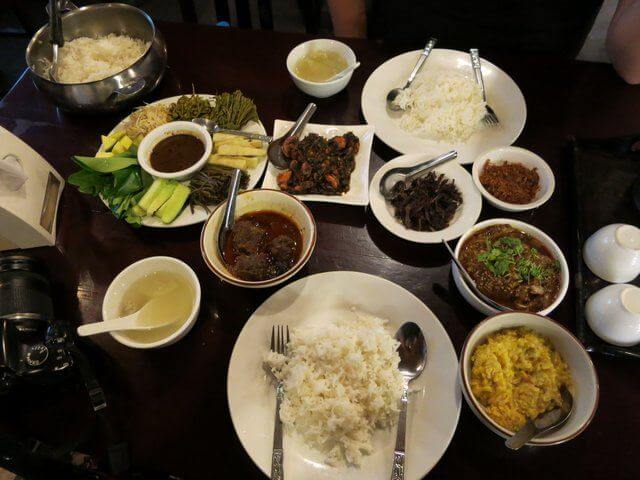
Myanmar curry, served with a selection of side dishes
Myanmar’s national dish is Mohinga, a thick fish broth with rice noodles, but the most widely eaten seemed to be curry. Our favourite was rapidly established as the rich, red mutton or pork curry.
Myanmar dishes are quite different from those in the rest of South East Asia and India. The same basic ingredients (garlic, ginger and chilli) are combined with only a few other ingredients per dish to create soft but surprisingly complex flavours. Main dishes are rarely hot or spicy – these flavours being added by the sometimes overwhelming array of side dishes.
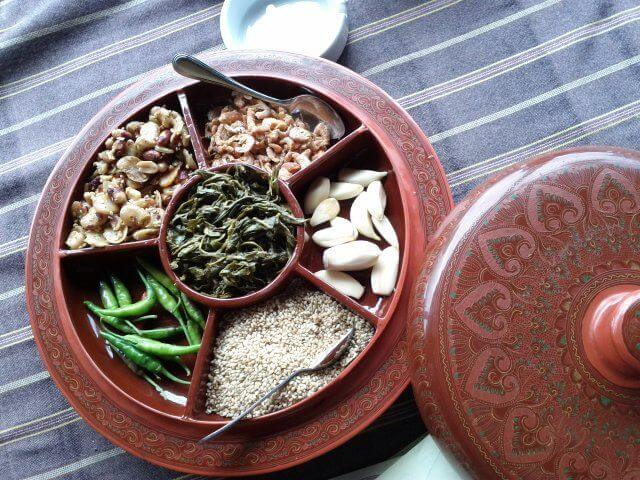
A common appetiser, served in a lacquerware dish. Clockwise from top left: spiced butter beans, dried shrimp, garlic, sesame and very hot chilli.
Ordering a simple curry includes rice, a large basket of salad, a slightly sour soup (often fishy or tamarind) to clear the palate, a vegetarian curry, prawn sambal for heat, a dried meat or fish for texture and a vegetable or three. Many restaurants then offer candies, tea-leaves, crisps or peanuts as both appetiser and dessert.
Other popular dishes include Ohn No Kauk Swe, a coconut cream and chicken soup served over noodles; mild fish curries and in Mandalay a noodle dish called Mondhi.
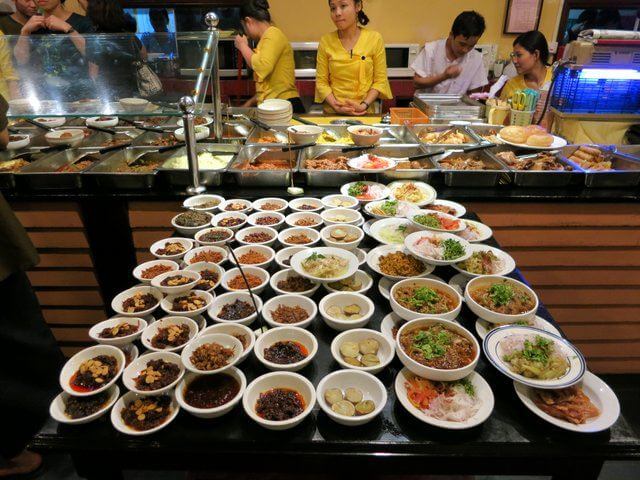
Ready made cold dish selection
How to order curry
Despite the long menus and dazzling selection of dishes on offer, ordering in a Myanmar restaurant is quite easy once someone tells you how.
First choose your protein: Mutton, pork, chicken, beef and fish are common choices. Sometimes these are selected from the menu, but often you’ll be led up to a counter where the ready-made dishes are on display.
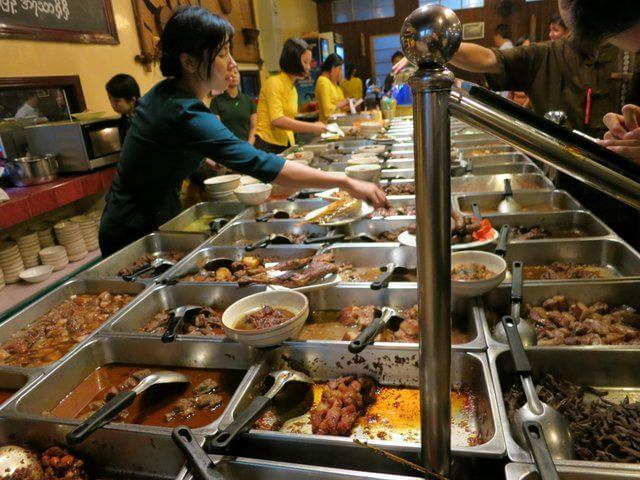
Ready made curries in Feel Restaurant (see below)
Take a seat again. Your choices will be put in bowls and carried back to your table by a waiter.
Then choose vegetables. One is usually adequate, as the side dishes are always filling and come with a salad.
The side dishes always arrived first. It’s not bad manners to start eating as your food arrives as there can be long delays between dishes.
Few Burmese people seem to order drinks, instead using the soup to wash the meal down. If you’re visiting during the hot season you’ll need all the drink you can find.
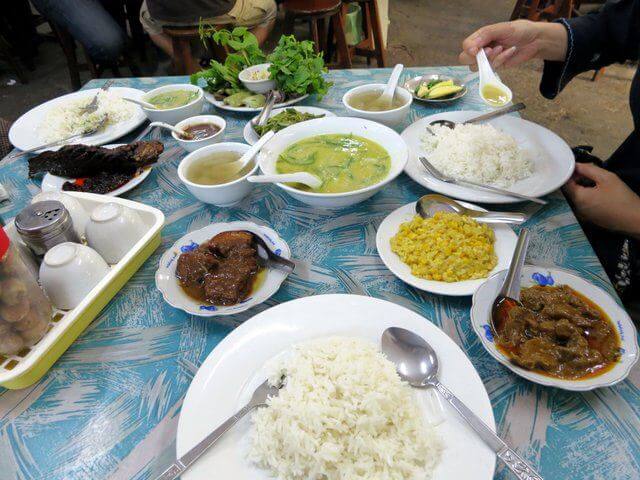
Lunch in a truck drivers cafe
Recommended restaurants in Myanmar
Feel (No. 124, Pyihtaungsu Avenue, Dagon Township)
Offers a wide variety of Burmese curry dishes all at around 2000 kyats. We ordered beef curry, deer jerky, corn and oil, fried spiced prawns, eggplant with caramelised onions, very spicy prawn sambal.
All this came with free fish soup, rice and a salad of bamboo, lime leaves, bitter betel leaves and berries, bamboo shoots, cucumber and winter melon, all served round a thin and very spicy prawn dip.
KeCo Teppanyaki, Yangon
Has a huge covered seating area. Walk to the front to choose meats and vegetables, which are taken away and BBQ’d. Served with an excellent selection of side dishes.
Pannar Myanmar Cuisine, East of the Myo Ma market, Old Tan Lay Street, Sagaing, ph: 072-21061
No recollection, but if I kept the card it must have been good.
Star Beans, Myanmar and Asian Foods, North of Annada Temple in Old Bagan
New restaurant serving a modern take on Burmese cuisine. Friendly chef who is happy to explain the dishes.
Min Min Restaurant, Myanmar and Chinese food, 83rd Street – between 26th and 27th Sts., Mandalay
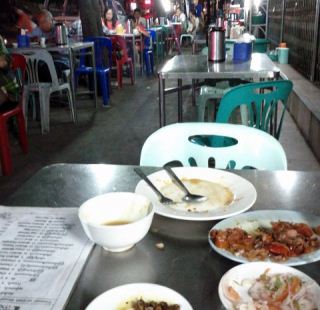
Karawek Cafe in Mandalay
Well recommended Burmese/Chinese restaurant a few minutes from the Mandalay City Hotel. Also look to the other side of the street for the Karawak Cafe.
Karawek Café – The absolute best curry we tasted.
During our time in Myanmar we ate in street stalls, tourist restaurants, five star hotels, local community restaurants and hugely popular chains. By far this was the best food we tasted. Mutton Curry, cooked for eight hours in a fruity sauce, served with sweet coconut rice. All for less than $3 – a far cry from the $25 biryani at our hotel in Inle Lake.
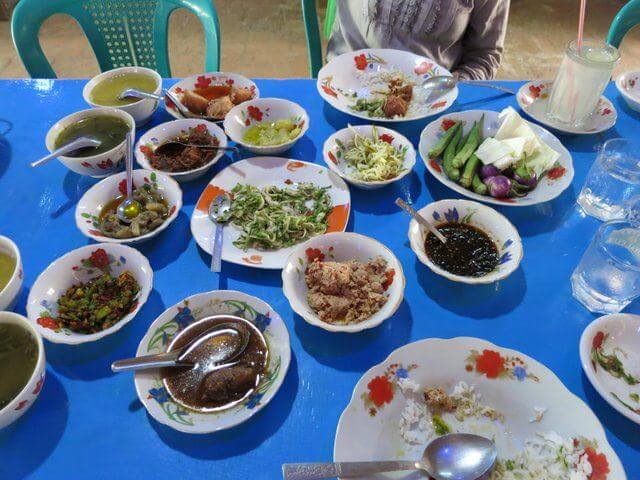
Lunch served outside in Bagan
Ones to avoid
Green Elephant Restaurant, Mandalay
Pleasant setting, but a boring selection of overpriced dishes, and the only place in Myanmar that made us both ill.
Too Too Restaurant, Mandalay
Well recommended in guide books and by hotel staff (which may mean they pay the most commission), but we found the food to be below average.
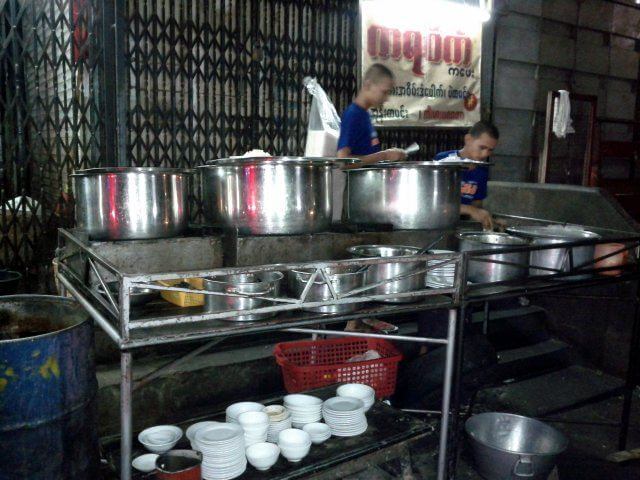
Kitchen at the Karawek Cafe
Burmese Pork Curry Recipe (Wethani Kyet)
This is adapted from a Charmaine Solomon recipe to make it taste more like our favourite curry in the Karawak Café. It serves 6.
1.5kg diced Pork (mutton or beef would work just as well)
3 large onions
20 cloves of garlic
1 cup of peeled, chopped fresh ginger
2 teaspoons of salt
2 tablespoons of vinegar
1 teaspoon of chilli powder
1 teaspoon of paprika (mostly for colour)
8 tablespoons of peanut oil
4 tablespoons of sesame oil
1 teaspoon of ground turmeric
Put onions, garlic and ginger into food processer and process until mushy. Turn contents into a sieve or nylon strainer set over a bowl and push with the back of a spoon to get as much of the liquid as possible.
Pour this liquid into a large saucepan; add the pork, salt, vinegar, chilli powder and half the peanut oil. Bring to the boil, cover and simmer over a low heat for one and a half hours until pork is almost tender.
In another large pan with a heavy base, heat remaining peanut oil and the sesame oil. When very hot add the garlic, onion and ginger solids left in the strainer. Add paprika and turmeric, stir and cook over low heat until it smells cooked and the oil floats to the top. The longer and slower you do this, the better it tastes.
Add a tablespoon of water from time to time to prevent it sticking. It takes at least 25 minutes to reach this stage. Halfway through cooking the onion spoon off some of the oil that has risen to the top of the pork and add it to the onions.
When onions and ginger are a reddish brown add to the pork and cook uncovered until the oil separates again and the liquid is almost evaporated. Stir frequently to prevent sticking.
Serve with white rice and a simple salad.
Despite all the chilli and garlic, the taste is very mild as it’s cooked for a long time.
This recipe is adapted from Charmaine Solomon’s Complete Asian Cookbook on page 227. A slightly different version appears in her excellent book Asian Favourites
on page 26
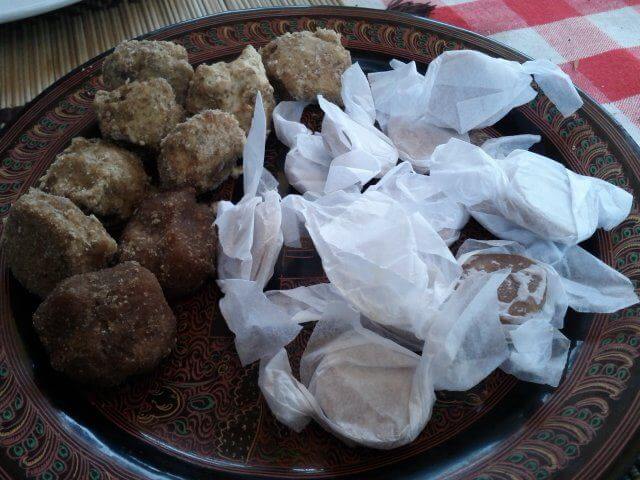
Like all good meals in Myanmar I’ll finish with Jaggery, the unrefined sugar sweet often served for dessert.








Pingback: @nomadfamtravels
Pingback: @jkpittman
Pingback: Dr. Jessica Voigts (@WanderingEds)
Pingback: Chris & Tawny (@CaptainandClark)
Hungry. Now.
I did eat too much when I was there, and there’s lots of other dishes to try as well
Aaaand there aren’t more Burmese restaurants around the world WHY? This looks amazing! I wonder if the waiters would be confused if I pointed to several dishes at the same time….all for me. I’m not sharing.
It is just excellent food, and not being too spicy I think would do really well around the world
Well I was going to say thanks for making me hungry, but then you finished with the recipe so I guess I’m good to go….nice touch:)
I had no idea a “simple” curry meal was so complex. Fascinating!
The food here looks delicious even though I’m not a big curry fan. My husband is and I am passing on the recipe to him.
Hopefully you’ll still enjoy it as it’s more flavourful than spicy
Great list Great list!!
You just make my hungry! XD
Yum! I had Burmese food in San Francisco and it was amazing – I’m sure it’s not as good as in country, but I still remember how tasty it was. This is an excellent guide!
It was the first time I’d tried Burmese food – it’s a shame it’s not more widespread
All the food looks amazing! Your photos are making me want a curry now, ans its 9am!